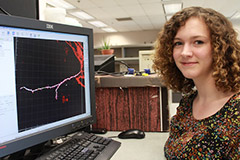Coming into focus
By Alisa Kim
A physics lab may seem like an unusual placement for someone doing a double major in microbiology and Spanish, but Shonara Gibson's summer studentship in the lab of Dr. Kullervo Hynynen has been fruitful.
"I really do enjoy this," says Gibson, of her work in the focused ultrasound lab led by Hynynen, who is the director of Physical Sciences at Sunnybrook Research Institute (SRI). Gibson is one of several university and high school students working in the lab this summer.
A pioneer in therapeutic ultrasound, Hynynen also holds the Canada Research Chair in Imaging Systems and Image-Guided Therapy. He is exploring the use of focused ultrasound to open the blood-brain barrier, tightly packed cells lining the inside of the brain's smallest blood vessels that prevent substances—bad and good—from reaching the brain. The aim is to open the barrier just long enough for targeted delivery of therapy for brain disorders including Alzheimer's disease, stroke and brain cancer.
Gibson, a third-year student at Dalhousie University, is studying the effects of focused ultrasound on the dendrites of brain cells. Dendrites are short, tree-like extensions protruding from brain cells that receive information from other brain cells and transmit electrical stimulation to the body of the cell. "We're using different levels of focused ultrasound power and seeing what the effects are on the brain. We want to see if there's a detrimental effect, no effect or a beneficial effect," she says.
Using a special dye, Gibson stains cross-sections of rat brains treated with 50%, 65% and 100% of maximum focused ultrasound power. She takes high-resolution images of the stained sections using a confocal microscope, which can make 3-D reconstructions from the obtained images. She then analyzes them using software that counts the dendritic spines and classifies them according to size, shape and structural features. Dr. Alison Burgess, a research associate in Hynynen's lab who supervises Gibson's work, trained her to use the microscope and do staining techniques.
"We've found that focused ultrasound doesn't have much of a detrimental effect at 50% and 65% of maximum power, which would be [the levels] used clinically to disrupt for drug delivery," notes Gibson.
She presented her findings at a weekly meeting of the lab's 30-plus members, an experience she found useful, but nerve-wracking. She says she is looking forward to next week's summer student poster competition, where she can share her work with smaller groups of people.
Gibson says being part of the D+H SRI Summer Student Research Program has given her hands-on experience that has made scientific methods more concrete. "It's been great. It was the first time I have taken control of an experiment and presented it from start to finish. Alison's writing the paper for it, and I'm helping out with that. You can really see how what you're working on is applicable to the world of science."



